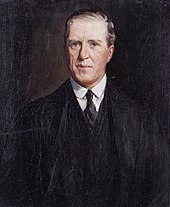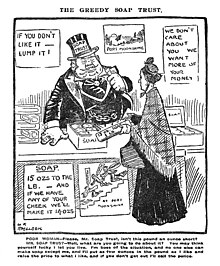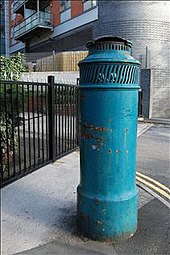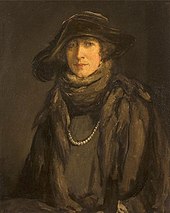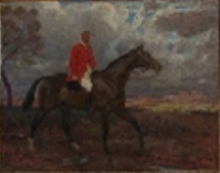Joseph Watson, 1st Baron Manton
He was chairman of Joseph Watson & Sons Ltd, soap manufacturers of Leeds, and a director of the London and North-Western Railway, in the late 19th century the largest joint stock company in the world.
[citation needed] Joseph went to work at his grandfather's company, Joseph Watson & Sons,[nb 1] and turned the company from the medium-sized concern built up by his father and uncle Charles into one which ruled the soap market of North-East England, with national and international sales, becoming William Lever's biggest rival.
The Northcliffe Press in its expanding and highly popular campaign overstepped the mark by falsely asserting trust soaps were made from scented fish oil.
Although Watson and Lever won substantial libel damages from the press, losses in reputation and profits had been suffered all round.
[12] Watson then suffered substantial losses in an unsuccessful speculation in linseed, and he sold Olympia Oil & Cake to the Dutch firm Jurgens, which had outbid Levers.
The Asquith government fell, to be replaced by that of Lloyd George, recently appointed Minister of Munitions to resolve the crisis.
Watson, as chairman of a six-man "Leeds Munitions Committee" made up from local industrialists in August 1915, was charged by the government to immediately establish the first of 12 National Shell Filling Factories.
He was a prominent racehorse owner and in 1918 acquired from Alec Taylor, Jr. the famous Manton training establishment near Marlborough in Wiltshire,[25] going on to spend £30,000 on yearlings.
[26] In 1921 he won The Oaks with Love in Idleness, and the Grand Prix de Paris, the world's richest racing prize (400,000 Francs), with Lemonora which also had gained third place in the Derby that year, all ridden by jockey Joe Childs.
[28][full citation needed] A half-length bronze bas-relief portrait of Watson in his baronial robes is displayed there in the George Street entrance hall, under which is inscribed A Wise Counsellor and Generous Benefactor.
[30] He had purchased the Robert Adam neo-classical mansion Compton Verney and its 5,079-acre (20.55 km2) estate in 1921 from Lord Willoughby de Broke, intending to make his seat there, which intention was not realised due to his sudden death in March 1922, before having taken up residence.
[nb 6] Whether his elevation, at the behest of Lloyd-George, was the result of a political donation, has not been proved but the title is not amongst those generally quoted by commentators as falling into this category.
The arms of Baron Manton became :"Argent, on a chevron azure between 4 martlets 3 in-chief and 1 in-base sable a crescent between 2 roses of the field".
[32] The armourials of Watson of Saughton were: "Argent, an oak tree growing out of a mount in base proper surmounted of a fess azure".
